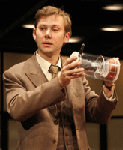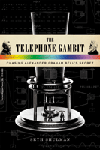
IP Intrigue: From Patent Battle to Bestseller
Once thought esoteric or dull, IP is becoming a favorite subject for thrillers, theatrical drama and charged historical debate. Readers may recall the 2006 best-selling novel Errors and Omissions by Paul Goldstein, in which a copyright lawyer is embroiled in international intrigue while verifying IP rights for a spy movie franchise. Goldstein’s inspiration came from a case in which he helped defend the rights of MGM and United Artists to the James Bond series. Recently, two new works inspired by patent battles have been attracting media coverage.
TV drama
The Farnsworth Invention opened on Broadway in December to packed audiences. Aaron Sorkin’s fast moving play follows the race to invent television that pitted farm boy genius Philo T. Farnsworth against media mogul David Sarnoff.

“You go get a generator. Cliff and I are going to start building a lab.” Jimmi Simpson as lone genius Philo Farnsworth. Photo © Joan Marcus, 2007
Born in 1906, Farnsworth came up with the idea for what would become the television while still a schoolboy. Blackboard drawings from his high school chemistry class would even serve as evidence in a patent interference case. He filed a patent for the Image Dissector, the first completely electronic television system, in 1927. He demonstrated the “Image Dissector” to the press in 1928 – sending a dollar sign as a first image to his worried investors – and transmitted the first human images a year later. Farnsworth was granted patents for his moving picture broadcasts in 1930.
Like many inventors, Farnsworth built on the technological advances of other inventors before him. But he was the first to invent an electric television with no mechanical parts – he recognized early on that the broadcast of a satisfactory image required speed that would be impossible to generate mechanically.

“If we make him an offer, it means he invented television.” Hank Azaria as media mogul David Sarnoff. Photo © Joan Marcus, 2007
Sarnoff, in charge of radio broadcasting at the Radio Corporation of America (RCA), and its president from 1930, saw the massive potential for television. In 1928 he decided to fund engineer Vladimir Zworykin’s research on an electric television. Zworykin thought he would need only US$100,000 and two years to bring his project to fruition. Instead it took eight years, a visit to Farnsworth’s laboratory – where Farnsworth gave him some of the answers to the technical problems he was having – and some US$50 million.
In 1931 Farnsworth refused Sarnoff’s US$100,000 offer for his patent, starting a long legal battle with RCA which left him broke and unable to commercialize his patent. Farnsworth won the battle in 1939 when RCA was ordered to pay Farnsworth US$1,000,000 in royalties. But Sarnoff won the war when Zworykin’s became the accepted standard for television.
The Broadway play blurs some of the historical facts – for example Farnsworth’s patents were upheld in court, a fact the play denies. But as reviewer Vindu Goel (The Mercury News) comments, “It’s great fun to watch…and offers some enduring lessons about business and technology.”
Telephone’s inventor on the line
Fanning the flames of contention – now smoldering for well over 100 years– journalist Seth Shulman’s new book, The Telephone Gambit, draws on Alexander Graham Bell's notes which, he claims, provide proof that Bell stole the telephone patent from Elisha Gray. The controversy over the true inventor of the telephone began in 1876 when Bell filed his patent.

Did Alexander Graham Bell steal the telephone patent? Seth Shulman investigates the evidence from Bell’s note books. (Publisher WW Norton. 2008).
The race to invent the telephone heated up in the middle of the 19th century. Many inventors filed patents for devices that ultimately failed. In its first 18 years, the Bell Telephone Company fought and won over 600 legal battles with inventors and tinkers, all claiming to have priority over Bell’s invention. Most demonstrated devices that could transmit noises – a click, a buzz, a ping – but none could transmit intelligible speech. Among the more successful claimants were Elisha Gray and Antonio Meucci.
In 1871, Meucci filed a patent caveat (a notice of intent to file a patent, which bars the issue of a patent to any other person regarding the same invention for a one year period) for the “teletrofono.” Meucci renewed the caveat in 1872 and 1873, but failed to do so after 1874, leaving Alexander Graham Bell free to file his patent in 1876. When he did, Meucci sued for infringement.
In the early stages, Meucci appeared to be winning his case: not only did the U.S. Government move to annul the patent issued to Bell on the grounds of fraud and misrepresentation, but the Secretary of State also issued a statement that "there exists sufficient proof to give priority to Meucci in the invention of the telephone." However, Judge William J. Wallace favored Bell in his decision of 1886, noting that the Meucci phone was mechanical, not electric. The Meucci case against Bell was then postponed from year to year until Meucci’s death in 1896, when the case was dropped.
But others picked up his fight and, over 100 years later in 2002, the U.S. House of Representatives issued a Resolution (HRES 269 EH) that “the life and achievements of Antonio Meucci be recognized, and his work in the invention of the telephone should be acknowledged.” That may have satisfied some, but others cried foul. There are arguments from both camps on the Internet.
Bell and Elisha Gray both filed patent applications on February 14, 1876. Gray, who at first congratulated Bell on his invention, later sued him for stealing his idea. In The Telephone Gambit, Seth Shulman argues that Elisha Gray was right in his affirmation.
Shulman claims that not only do Bell’s lab notes condemn him, but so does a signed confession from a patent examiner admitting he showed Gray’s patent filing to Bell on February 26. Gray’s patent file gave details of his discovery that wire immersed in water could transmit sound more easily. Shulman claims that Bell’s notes show a sudden discovery of immersed wire as a conductor for sound on March 8, just in time for the now famous "Watson, come here. I want to see you" public demonstration of Bell’s invention on March 10.
It also seems that Gray’s application was filed earlier in the day on February 14 than Bell’s, but that Gardiner Hubbard, a well-known patent lawyer who also happened to be Bell’s father-in-law and business partner, used his connections at the U.S. Patent Office to have Bell’s application fast-tracked and approved before Gray’s. The book makes for good reading and calls for a re-writing of history.
Never a dull day in the world of patents! Who knows, a bit of digging in those dusty files may be enough to turn up the plot of the next best-seller or Broadway hit.
By Sylvie Castonguay, WIPO Magazine editorial team, Communications and Public Outreach Division
The WIPO Magazine is intended to help broaden public understanding of intellectual property and of WIPO’s work, and is not an official document of WIPO. The designations employed and the presentation of material throughout this publication do not imply the expression of any opinion whatsoever on the part of WIPO concerning the legal status of any country, territory or area or of its authorities, or concerning the delimitation of its frontiers or boundaries. This publication is not intended to reflect the views of the Member States or the WIPO Secretariat. The mention of specific companies or products of manufacturers does not imply that they are endorsed or recommended by WIPO in preference to others of a similar nature that are not mentioned.